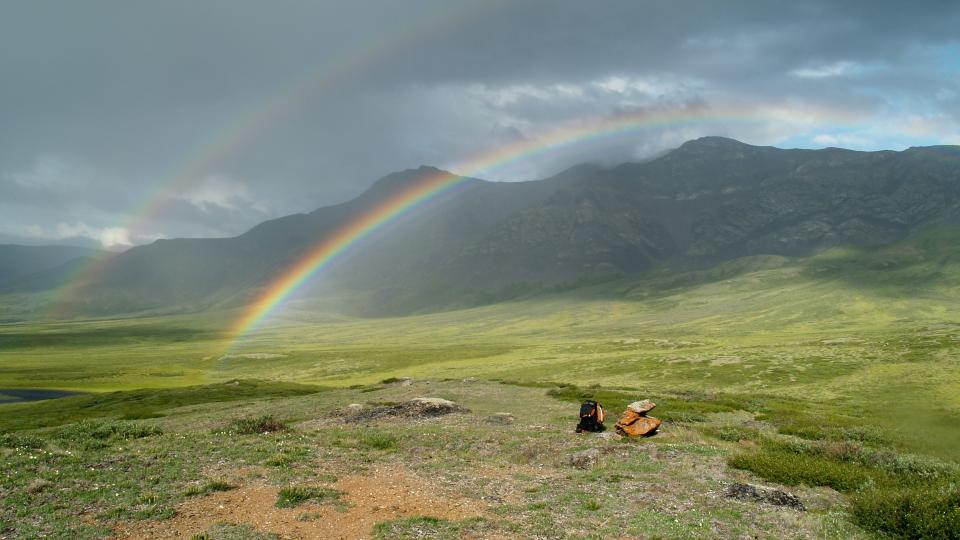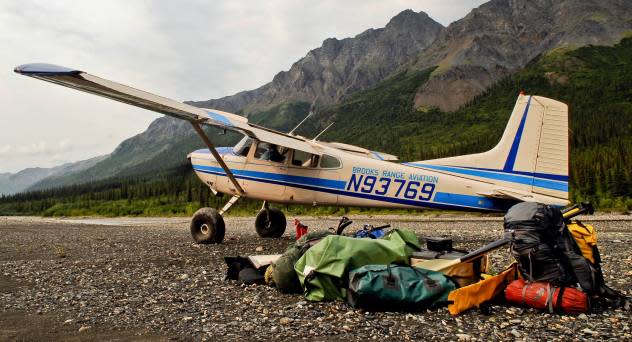This little-known national park north of the Arctic Circle is 'not for the faint of heart'
 |
A glacial stream merges with a clear stream in the Noatak River drainage in the Gates of the Arctic National Park. (NPS) |
In the vast wilderness of northern Alaska just above the Arctic Circle lies the most remote national park in the United States, an off-the-grid destination that has become even more difficult to access in the age of COVID-19.
Gates of the Arctic National Park and Preserve, located around 200 miles northwest of Fairbanks, Alaska, is a pristine 8.4 million-acre landscape filled with towering mountains, glacier-carved valleys and untouched forests.
"It's not for the faint of heart," Kris Fister told AccuWeather. Fister is the Chief of Interpretation and Education at Gates of the Arctic National Park and Preserve. "Gates was created to be a wilderness park, i.e. one without development where visitors can experience the land as it has existed for thousands of years."
The park has no roads, no trails and no campsites, so those with an adventurous heart embarking on the long journey to Gates of the Arctic need to either forge their own way through the Alaska backcountry or charter a plane for a flight into the park (and make plans for a return flight back to civilization).
"You're on your own. There is no cell phone service and there are no amenities or services in the preserve. Visitors must be self-reliant and able to execute self-extraction and communication, should an emergency situation arise," the National Park Service (NPS) explained on its website.
Visitors may count more bears, moose and marmots than they do other people during their stay in the park. In 2019, only 10,518 people visited Gates of the Arctic, making it the least-visited national park in the U.S. For comparison, nearly 6 million people visited the Grand Canyon in 2019.
 |
A full, double rainbow arcs across the Killik River valley in the Gates of the Arctic. (NPS/Christopher Houlette) |
However, 2020-21 has been significantly different due to COVID-19.
"Visitation for Gates has been severely impacted by the pandemic," Fister told AccuWeather.
In the early stages of the coronavirus pandemic, most national park sites across the U.S. shut down, although many have since reopened with new restrictions and guidelines in place. As of September 2021, however, renewed COVID restrictions once again prohibited recreational access to the park via the village of Anaktuvuk Pass.
It is one of the more popular sites for people to begin their journey into Gates of the Arctic.
 |
A Brooks Range Aviation Cessna 185 airplane at the gravel bar landing strip at the Gates of the Arctic on the North Fork Koyukuk River. (Alaska National Parks/Josh Spice) |
Park officials have taken notice to the dramatic changes in the volume of visitors.
Nearly 2,900 visited the park in 2020, the lowest number since 1994, according to park officials. It's a significant drop, but still well above the all-time record for fewest visitors in one year.
Gates of the Arctic was established as a national park in 1980, but visitation records did not begin until 1982. The only year when fewer than 1,000 people visited the park, was in 1989 when park officials tallied just 822 guests, according to the NPS records.
CLICK HERE FOR THE FREE ACCUWEATHER APP
Those that are able to make it to the park despite the new health-related restrictions must be sure that they are prepared for anything and everything ranging from encounters with dangerous wildlife to unexpected shifts in the weather.
"Your ability to deal with the rapidly changing weather in and around Gates of the Arctic National Park & Preserve could well determine the level of satisfaction you derive from your trip into the Arctic," the NPS said. "Be prepared for rapid, severe changes in the weather."
"The park could experience snow at any time of the year, and hypothermia is something we warn backcountry users about, as summers typically get wetter as the months go on, with shorter days and cooler temps," Fister added.
Poor weather could delay air travel to and from the park, meaning that those relying on a flight home should plan accordingly so they do not run out of food and supplies if the weather forces the return trip to be delayed.
The winter months feature the harshest weather conditions. Since the park is north of the Arctic Circle, it is shrouded in complete darkness with no glimpses of sunlight surrounding the solstice. Temperatures can plummet below minus 40 amid the constant darkness.
All of these elements may be too much for some people to even think about traveling to Gates of the Arctic, but to others, a trip to this remote national park may sound like the adventure of a lifetime.
An awe-inspiring landscape devoid of civilization is what inspired the famous naturalist John Muir to write a plethora of poetry that could be fitting for travelers to read as they start their first journey in Gates of the Arctic National Park and Preserve: "Walk away quietly in any direction and taste the freedom of the mountaineer."
KeFor the latest weather news, check back on AccuWeather.com. Watch the AccuWeather Network on DIRECTV, Frontier, Spectrum, fuboTV, Philo, and Verizon Fios. AccuWeather Now is now available on your preferred streaming platform.





